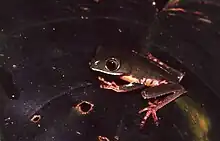Callimedusa tomopterna
Callimedusa tomopterna, the tiger-striped tree frog, is a species of frog in the subfamily Phyllomedusinae. It is found in northern South America in the Upper Amazon Basin of Bolivia, Peru, Ecuador, and Colombia, Amazonian Brazil, and the Guianas from southeastern Venezuela to French Guiana. It might represent more than one species.[2]
| Callimedusa tomopterna | |
|---|---|
 | |
| Scientific classification | |
| Domain: | Eukaryota |
| Kingdom: | Animalia |
| Phylum: | Chordata |
| Class: | Amphibia |
| Order: | Anura |
| Family: | Hylidae |
| Genus: | Callimedusa |
| Species: | C. tomopterna |
| Binomial name | |
| Callimedusa tomopterna (Cope, 1868) | |
| Synonyms[2] | |
| |
Callimedusa tomopterna is an arboreal species that occurs in pristine tropical rainforests, usually on trees around temporary to semi-temporary pools during the wet season, but specimens have been also collected in open areas and floodable forests on shrubs and aquatic edges. It occurs at elevations up to 500 m (1,600 ft) above sea level. It is an uncommon species in most parts of its range. It can locally suffer from habitat loss.[1]
Behavior and reproduction
Callimedusa tomopterna are nocturnal and sleep throughout the day. During the nighttime, the males are able to communicate to the females through vocal calls. During the nighttime is when they also search for food.[3] The reproductive aspects reported for the species of this family are marked by the uniqueness of egg deposition, placed on green leaves hanging under standing water, where the tadpoles will complete their development.[3] The lack of availability of sites for reproduction can lead to sites being shared by anuran species, which can sometimes lead to interspecific mating. This is especially seen when males are actively looking for females through satellite behavior or have limited capacity to differentiate between sexes. This is an often-common behavior in many neotropical frogs such as the Callimedusa tomopterna. Studies have shown interspecific amplexus between individuals from two different species: specifically, Callimedusa tomopterna (Tiger-striped Leaf Frog) and Dendropsophus minutus (Lesser Treefrog).[4]
Threats
Clutch Predation
In the Central Amazonia, treefrogs of the genus Phyllomedusa lay their eggs in gelatinous masses on leaves and branches over water. 59% of C. tomopterna clutches are often attacked by predators such as phorid flies (being the majorly responsible for clutch loss), and other unidentified predators. The reason for these clutch predations is mostly due to Anuran eggs being a high-protein energy source for many predators such as insects. They are especially notorious for larvae.[5]
Adult Predation
Adult Callimedusa tomopternas are also highly predated on. Studies have shown that the predation of adult Phyllomedusa tree frogs by the snake species, Leptodeira annulate (cat-eyed snake) reinforces the claim that the toxins that Callimedusa tomopternas are able to secrete for defense are not sufficient enough to protect them from the cat-eyed snakes.[6]
References
- Enrique La Marca, Claudia Azevedo-Ramos, Luis A. Coloma, Santiago Ron (2016). "Callimedusa tomopterna". IUCN Red List of Threatened Species. 2016: e.T55866A107289222. doi:10.2305/IUCN.UK.2016-3.RLTS.T55866A107289222.en. Retrieved 17 November 2021.
{{cite journal}}: CS1 maint: multiple names: authors list (link) - Frost, Darrel R. (2020). "Callimedusa tomopterna (Cope, 1868)". Amphibian Species of the World: an Online Reference. Version 6.0. American Museum of Natural History. Retrieved 7 January 2020.
- Thainá, Najar; Ferrante, Lucas. "The journey of life of the Tiger-striped Leaf Frog Callimedusa tomopterna (Cope, 1868): Notes of sexual behaviour, nesting and reproduction in the Brazilian Amazon". Herpetology Notes. 11: 531–538.
- Marin, Gliselle; Nissen, Bradley; Janssen, Jordi. "CALLIMEDUSA TOMOPTERNA (Tiger-striped Leaf Frog) and DENDROPSOPHUS MINUTUS (Lesser Treefrog) INTERSPECIFIC AMPLEXUS". Herpetological Review. 48: 605–606.
- Neckel-Oliveira, Selvino; Wachlevski, Milena (2004). "Predation on the Arboreal Eggs of Three Species of Phyllomedusa in Central Amazônia". Journal of Herpetology. 38 (2): 244–248. doi:10.1670/162-03A. ISSN 0022-1511. S2CID 86277566.
- Roberto dos Santos-Silva, Carlos; Santana-Andrade, Igor-Caio; Ferrari, Stephen; Araújo, Maria Nélia. "Predation of six anuran species by the banded cat-eyed snake, Leptodeira annulate (Serpentes:Dipsadidae), in the Caatinga scrub of northeastern Bahia, Brazil". Herpetology Notes. 7: 123–126. S2CID 85631653.
